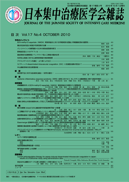Volume 17, Issue 4
Displaying 1-31 of 31 articles from this issue
- |<
- <
- 1
- >
- >|
HIGHLIGHTS IN THIS ISSUE
-
2010 Volume 17 Issue 4 Pages 453-456
Published: October 01, 2010
Released on J-STAGE: April 30, 2011
Download PDF (633K) -
2010 Volume 17 Issue 4 Pages 457-459
Published: October 01, 2010
Released on J-STAGE: April 30, 2011
Download PDF (560K) -
2010 Volume 17 Issue 4 Pages 459-461
Published: October 01, 2010
Released on J-STAGE: April 30, 2011
Download PDF (581K) -
2010 Volume 17 Issue 4 Pages 462-464
Published: October 01, 2010
Released on J-STAGE: April 30, 2011
Download PDF (562K) -
2010 Volume 17 Issue 4 Pages 464-467
Published: October 01, 2010
Released on J-STAGE: April 30, 2011
Download PDF (695K) -
2010 Volume 17 Issue 4 Pages 468-470
Published: October 01, 2010
Released on J-STAGE: April 30, 2011
Download PDF (613K) -
2010 Volume 17 Issue 4 Pages 471-473
Published: October 01, 2010
Released on J-STAGE: April 30, 2011
Download PDF (614K) -
2010 Volume 17 Issue 4 Pages 474-476
Published: October 01, 2010
Released on J-STAGE: April 30, 2011
Download PDF (559K) -
2010 Volume 17 Issue 4 Pages 476-478
Published: October 01, 2010
Released on J-STAGE: April 30, 2011
Download PDF (788K)
REVIEW ARTICLE
-
2010 Volume 17 Issue 4 Pages 479-489
Published: October 01, 2010
Released on J-STAGE: April 30, 2011
Download PDF (479K)
ORIGINAL ARTICLE
-
2010 Volume 17 Issue 4 Pages 491-498
Published: October 01, 2010
Released on J-STAGE: April 30, 2011
Download PDF (465K)
CASE REPORTS
-
2010 Volume 17 Issue 4 Pages 499-503
Published: October 01, 2010
Released on J-STAGE: April 30, 2011
Download PDF (399K) -
2010 Volume 17 Issue 4 Pages 505-512
Published: October 01, 2010
Released on J-STAGE: April 30, 2011
Download PDF (559K) -
2010 Volume 17 Issue 4 Pages 513-518
Published: October 01, 2010
Released on J-STAGE: April 30, 2011
Download PDF (444K) -
2010 Volume 17 Issue 4 Pages 519-524
Published: October 01, 2010
Released on J-STAGE: April 30, 2011
Download PDF (378K) -
2010 Volume 17 Issue 4 Pages 525-530
Published: October 01, 2010
Released on J-STAGE: April 30, 2011
Download PDF (506K)
BRIEF REPORTS
-
2010 Volume 17 Issue 4 Pages 531-532
Published: October 01, 2010
Released on J-STAGE: April 30, 2011
Download PDF (183K) -
2010 Volume 17 Issue 4 Pages 533-534
Published: October 01, 2010
Released on J-STAGE: April 30, 2011
Download PDF (317K) -
2010 Volume 17 Issue 4 Pages 535-536
Published: October 01, 2010
Released on J-STAGE: April 30, 2011
Download PDF (310K) -
2010 Volume 17 Issue 4 Pages 537-538
Published: October 01, 2010
Released on J-STAGE: April 30, 2011
Download PDF (268K) -
2010 Volume 17 Issue 4 Pages 539-540
Published: October 01, 2010
Released on J-STAGE: April 30, 2011
Download PDF (256K) -
2010 Volume 17 Issue 4 Pages 541-542
Published: October 01, 2010
Released on J-STAGE: April 30, 2011
Download PDF (311K) -
2010 Volume 17 Issue 4 Pages 543-544
Published: October 01, 2010
Released on J-STAGE: April 30, 2011
Download PDF (281K)
LETTERS
-
2010 Volume 17 Issue 4 Pages 545-546
Published: October 01, 2010
Released on J-STAGE: April 30, 2011
Download PDF (224K) -
2010 Volume 17 Issue 4 Pages 546-547
Published: October 01, 2010
Released on J-STAGE: April 30, 2011
Download PDF (207K) -
2010 Volume 17 Issue 4 Pages 548-549
Published: October 01, 2010
Released on J-STAGE: April 30, 2011
Download PDF (217K) -
2010 Volume 17 Issue 4 Pages 550-552
Published: October 01, 2010
Released on J-STAGE: April 30, 2011
Download PDF (218K)
ERRATA
-
2010 Volume 17 Issue 4 Pages 553A
Published: October 01, 2010
Released on J-STAGE: April 30, 2011
Download PDF (200K) -
2010 Volume 17 Issue 4 Pages 553B
Published: October 01, 2010
Released on J-STAGE: April 30, 2011
Download PDF (200K)
INVESTIGATION REPORTS
-
2010 Volume 17 Issue 4 Pages 555-559
Published: October 01, 2010
Released on J-STAGE: April 30, 2011
Download PDF (97K) -
2010 Volume 17 Issue 4 Pages 561-564
Published: October 01, 2010
Released on J-STAGE: April 30, 2011
Download PDF (329K)
- |<
- <
- 1
- >
- >|
